One Month Mega India Birding and Wildlife 2024 – Tour Report
Home › One Month Mega India Birding and Wildlife 2024 – Tour Report
31-Day India Birding and Wildlife Tour with Taj Mahal, Tigers, Endemic Birds, Great Food, and Natural Wonders
What a Trip
When I first saw the ad, probably on Facebook, I never really thought the trip would happen. The tour was organised by Endemic Explorer, and I already knew of a few of their guides. Then I spoke with Sabu, their tour director. He had a way of explaining things that made it all sound easy. With their team partly based in India and a strong reputation behind them, I started to feel more confident. But as the start date drew closer, the nerves crept back. It was a 31-day trip. It covered the whole country — west to east, north to south. One part even included the Andaman Islands, over a thousand kilometres out in the Bay of Bengal.
And so it began. January 2024. I landed in Delhi on the morning of the sixth. The flight from South Africa had been long. I had always pictured India as a hot place, but when I stepped outside, the cold hit hard. Much sharper than I expected. But before that, I have to mention the airport — modern, clean, well laid out, and nothing like the chaos I had imagined. It made a good first impression. Then came the first sensory jolt. As I stepped out, the smells rushed in — curry, exhaust, winter dust, and smoke — blending into something unfamiliar and strong. Not unpleasant, just intense. The street outside was buzzing. People everywhere. Some smiling, some calling out, some locked in hugs. It was noisy, alive, and full of energy. A bit chaotic, but with its own rhythm.
I went straight to the Ibis near the airport. Check-in was only at one, so I left my bags and asked about a short tour. The staff were kind and arranged a car. The driver spoke good English and was happy to show me around. He pointed out metro lines, old government buildings, and market streets as we drove through the city. We got back to the hotel around noon. My room was ready. I lay down for a quick nap and woke up at ten that night. I rushed down, grabbed a late dinner, and had my first proper Indian meal. It was simple — a curry and some rice — but the taste caught me off guard. This was not like Indian food I had eaten before. The spices were deeper, the flavours fuller. It made every curry I’d had in Europe feel like guesswork.
The next morning, I slept in again. Since we would end the tour far in the south, where the shops and souvenirs would be different, I decided to do my gift shopping in Delhi. I asked the hotel for another car. This driver was younger, more chatty, and knew the local stalls well. He even helped me haggle. I picked up a few things for family and friends, and by the time I got back, Sabu had arrived.
I had seen him before on video calls. Friends who had travelled with him had told me stories. But meeting him in person was different. He had that calm, travelled energy — the kind of presence that comes from years on the road. He spoke simply, listened carefully, and had a story for every question I asked. We sat down over a beer and talked for hours. It felt like catching up with someone I had known a long time.
That evening, I met two more travellers — Jinlong from Taiwan and Martin from Switzerland. They had travelled with Sabu before and were clearly comfortable right away. We talked a little, laughed more, and shared a quiet dinner. The rest of the group arrived early the next morning, on the official start day of the tour, the eighth of January. We all met for breakfast at seven. For most of them, it felt like a reunion. They had inside jokes, shared memories, old photos. I just listened and watched it all unfold. It was easy, warm, and full of laughter.
There were six of us in total — from Taiwan, Switzerland, Korea, the UK, and me, from South Africa. And then there was Sabu, keeping it all together. Just like that, the trip had begun.

The Road to Agra
We began our journey to Agra at eight in the morning on the eighth of January. Our group boarded a Tempo Traveller and joined the Yamuna Expressway, heading southeast out of Delhi. As the city gave way to open fields and cleaner skies, the mood in the van shifted. The road was smooth, the pace steady, and we made good time. We took two short breaks—one for coffee, and the other quite unexpectedly, when someone spotted an Egyptian Vulture perched alone on a bare tree. It stood in the middle of a wheat field, surrounded by golden stalks and silence.
Agra as a city did not make much of an impression. It was busy, a bit tired, and like many Indian towns, full of contrasts. But none of that mattered. We had come for the Taj Mahal. One of the most recognised buildings in the world, the Taj carries the weight of countless photographs and travel stories. Yet no picture truly prepares you for it.
We arrived in the late afternoon and went straight to the site. The sun was already low, casting a soft amber light across the marble. As we passed through the gate and walked towards the main platform, the dome rose slowly into view. The symmetry, the stillness, and the sheer presence of the structure were overwhelming. The marble changed colour with the sky, and the shadows stretched long across the garden. I walked quietly through the courtyard and stood at the base for a while, saying little. Some places are exactly what you hope for. This was one of them. I knew then I would return, with my family, to see it again.
Chambal River Safari
Two days later, we left early in the morning for the Chambal River. The road narrowed as we moved southeast, passing through small towns and fields slowly warming under the sun. By half past nine, we had reached the riverbank and boarded a simple boat. The water was calm, covered in patches of morning mist. The air was crisp, and the river ran slow and steady beneath the hull.
This part of the season was slightly early for Indian Skimmers, but a few had already arrived. We spotted them standing quietly on the sandbars, their shapes sharp and clear against the pale riverbank. The boatman cut the engine and pointed ahead. Just then, a Gangetic River Dolphin surfaced briefly, its back arching out of the water before disappearing again. The ripples lingered longer than the sight. The boatman smiled. These moments are not guaranteed here, and we all knew we had been fortunate.
The boat drifted into a more secluded stretch. A marsh crocodile lay near the edge, its body sunk into the mud, eyes just above the waterline. We searched the banks for a glimpse of the elusive gharial, but it did not appear. Just as we began turning back, we saw two Sarus Cranes. They stood together in the shallow water, motionless and tall, their red crowns glowing in the soft light. Their reflections stretched beneath them, and the river around them fell quiet. It was an unhurried moment, and the perfect way to close the morning.
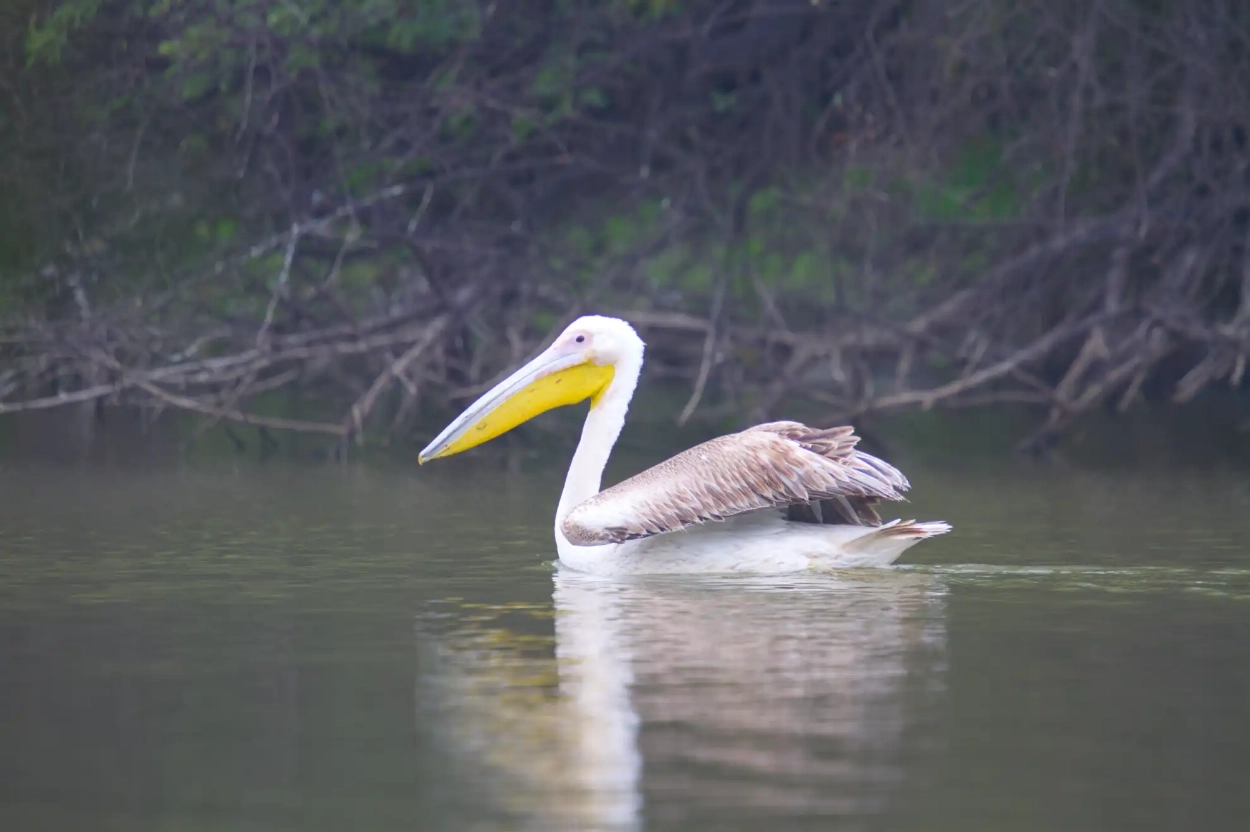
Bharatpur Bird Sanctuary: A Birder’s Paradise
We drove to Bharatpur after leaving Chambal behind. Once a royal hunting ground, the sanctuary is now protected as a UNESCO World Heritage Site and stands as one of the best places in India for birdwatching. We checked into The Birder’s Inn, a quiet lodge near the entrance gate. It was modest, well kept, and clearly run by people who understand birders. Though the sanctuary can be explored on foot, we chose the more relaxed route—cycle rickshaws. These slow-moving rides allowed us to scan the trees without distraction and helped us cover more ground.
Our local guide, Mr Prem Singh, was calm, observant, and deeply familiar with the species of the region. He spoke clearly, pointed out field marks without over-explaining, and never rushed. Over two full days, we focused entirely on photography. Flocks of painted storks, marsh harriers, Indian rollers, and the rare Siberian rubythroat—each sighting was memorable. I had seen many of these birds before, but something about the light, the setting, and the pace made it all feel new. Bharatpur offers not just birds, but a rhythm that slows you down in the best way.
Ranthambore: Into the Realm of the Tiger
On the seventh day, we packed up early and made our way west to Ranthambore National Park. It was a long drive—nearly five hours—but the road gave us a glimpse of rural Rajasthan. The landscape had changed. No more highways or city buzz. This was open country. We passed small towns, sleepy farms, and roads where cows held up traffic as naturally as if they owned the place. It felt like stepping into another India. We reached our safari lodge by evening. The air was cooler here, and the lodge was everything we needed—comfortable rooms, good food, and a fire lit in the courtyard. Endemic Explorer always seems to get the accommodation just right, especially after long days in the field.
The Tiger Encounter
We had three safaris scheduled, spread across two days. The first drive was in Zone 2. The morning light filtered through the sal trees, and the forest was alive with birds and deer. But no tigers. That is how it goes. You wait, and sometimes the wild waits longer.
In the afternoon, we entered Zone 3. The mood shifted almost immediately. The jungle felt quieter, more focused. Then came the alarm calls—first a peacock, then the sharp cry of langurs. The driver cut the engine. For a few seconds, no one moved. Then, just ahead, she appeared. A tigress stepped onto the track, golden in the low light. She paused, turned her head, and looked across the forest. Her body was broad and calm. No noise. No rush. She held the space without effort. For those who have only seen tigers on screens, it is hard to explain what that moment feels like. The presence is physical. She stayed for half a minute, maybe more, then melted back into the trees.
The Final Surprise: A Leopard in the Trees
The next morning, on what was meant to be our last easy drive, the forest gave us one more moment. A leopard was resting in a large tree, high up, its body draped across a thick branch. It was half-hidden, but clear enough to recognise. It lay still, watching, not at all concerned by our presence. A leopard in broad daylight is rare. Most of us had never seen one like that before. After the tiger encounter, it felt like the park had offered its own quiet farewell.
Jaipur: A Taste of Rajasthan
After our final breakfast at the lodge, we drove north to Jaipur. This was not a sightseeing leg. We stayed near the airport for one night, with no time for forts, markets, or the famous palaces. But Sabu had something in mind. That evening, he took us to a local restaurant known for serving traditional Rajasthani thali. It was a proper meal. Hot rotis brushed with ghee, spiced lentils, tangy pickles, curd, vegetables cooked over coals, and a line of sweets placed neatly around the edge of the plate. We ate slowly, talked little, and ended the evening full and content. The day had been long, but the food made it feel complete.
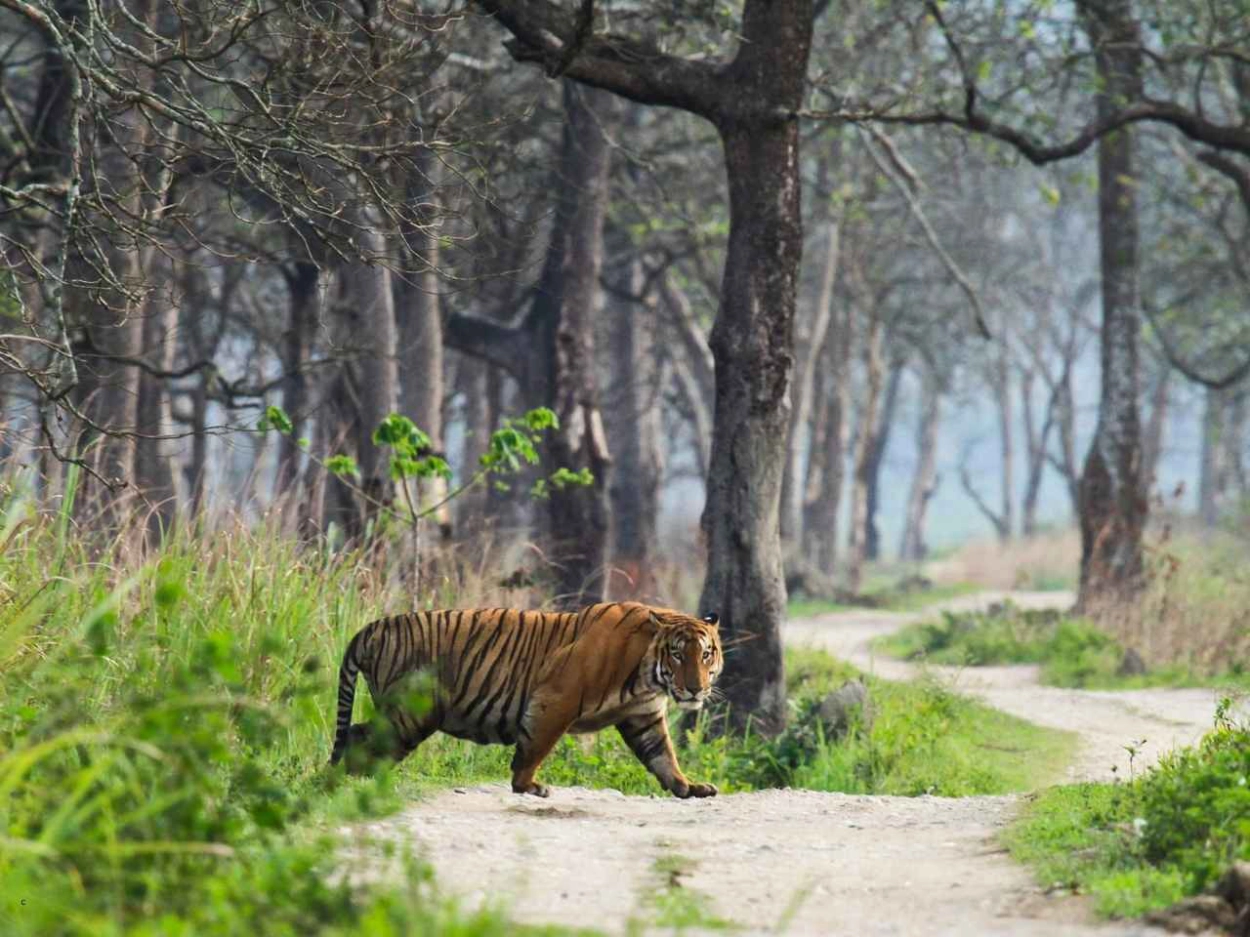
Into the Himalayas: The Journey to Kumaon
The next morning, we left for the airport. Our destination was Kumaon, tucked in the lower ranges of the Indian Himalayas. Since there was no direct flight to Sattal, we flew to Pantnagar with a brief stop in Delhi. Most of the day slipped by in transit, waiting at terminals, navigating boarding gates, and passing through security checks at a pace only airports can manage. But once we finally landed, Sabu’s local contact was there to meet us, ready with vehicles for the climb ahead.
The drive took us through forests and hillside towns, with the lights of scattered homes flickering through the misty dusk. By the time we reached Sattal, the temperature had dropped sharply. It was the kind of cold that cuts through clothes and settles deep, forcing you to tighten your jacket and move briskly. We ate a simple dinner, shared a few quiet words at the table, and headed straight to bed.
Sattal: A Birdwatcher’s Dream
Morning in Sattal brought with it a sense of stillness and promise. We made our way to a small wooden hide built near the edge of the forest. Soft light filtered through the trees, and the air was already filled with bird calls. As we settled in, the hide came to life with activity. Laughing thrushes, sibias, and nuthatches came and went in quick, sharp bursts, never staying long. The hide gave us hours of quiet reward. No rush, no chatter—just camera shutters and shared glances.
In the afternoon, we left the hide and followed a forest trail. There was talk of lifers, and everyone was hopeful. Halfway along the path, something quick and unexpected flashed across the undergrowth. A yellow-throated marten. It moved low and fast, crossing the trail in a blur of fur and muscle before vanishing into the woods. No one got a photo. There wasn’t time. But it did not matter. The moment was enough. It reminded us that the forest is alive in ways we rarely see.
The next day, we travelled higher to Pangot. The target was the Cheer Pheasant, a bird Sabu had seen and photographed more than ten years ago, though he warned us that sightings had become rare. Still, the forests around Pangot made the trip worthwhile. We spotted rusty-cheeked scimitar babblers, red-billed leiothrix, and white-throated laughing thrushes—all species that draw birders from around the world. After Pangot, we continued to Ranikhet, a quiet hill station about two hours away. Just as we pulled off near a slope of open grass, someone spotted it. The Cheer Pheasant. It stood tall for a few seconds before disappearing into the cover. Cameras clicked in bursts, but the real joy was in simply seeing it. Everyone knew how lucky we had been.
As the day wound down, we spotted a Himalayan Griffon Vulture circling high above us. It glided across the sky, wings stretched wide, moving without effort. The kind of sight that brings a quiet end to a remarkable day.
Jim Corbett: A Different Kind of Safari
We left the hills behind and descended into the Doon valley, heading for Jim Corbett National Park. The forest here felt denser and heavier, and the air was warmer, almost humid. Unlike Ranthambore, we were not here to chase tigers. We had a different list this time—species that many spend years searching for. The Great Indian Hornbill, Slaty Woodpecker, Tawny Fish Owl, Wallcreeper, and Ibisbill.
We divided our time over two days, splitting between river edges, forest tracks, and open clearings. One by one, the birds showed up. Some were distant, just shapes in the branches. Others came closer, giving us just enough time to focus and capture a frame or two. It is rare for a plan to come together so well in the wild, but somehow this time, it did. None of us said it out loud, but we all knew this leg had been special.
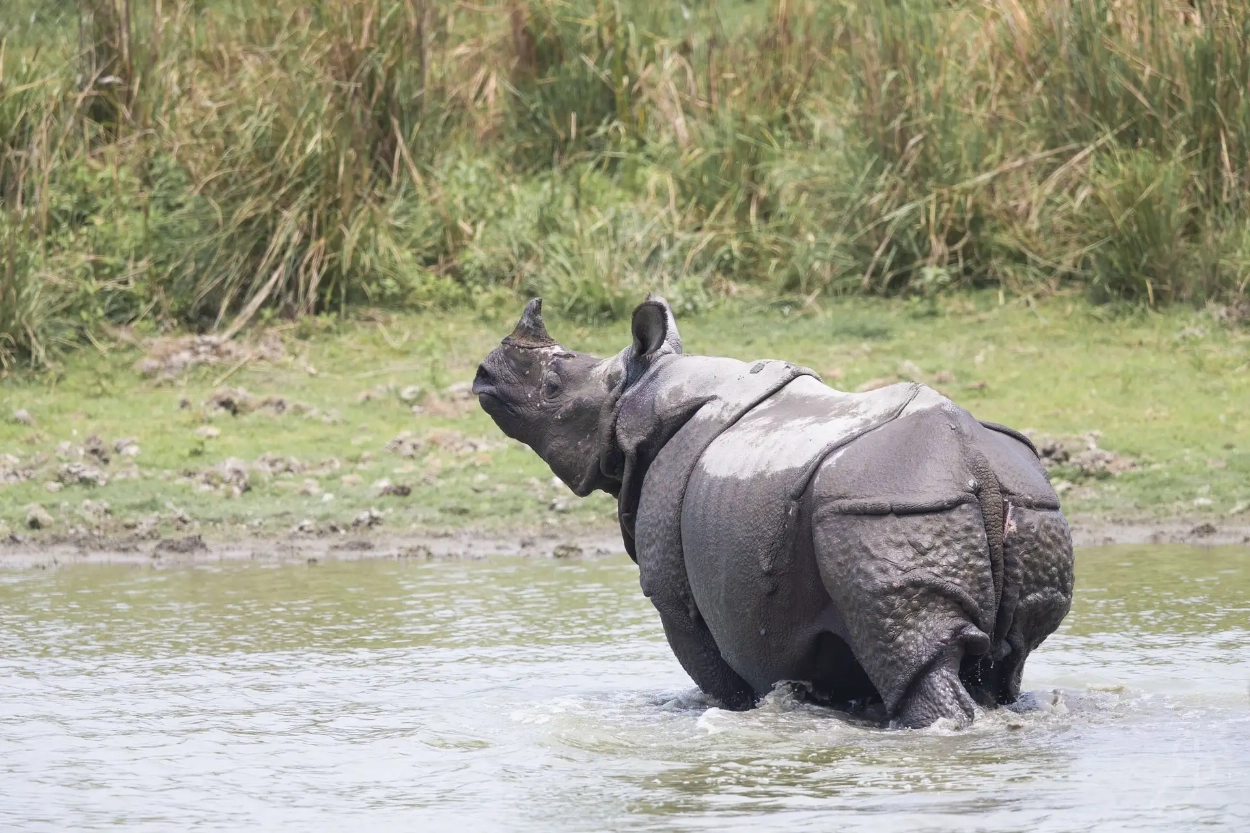
Bound for Assam
After four full days in Kumaon, it was time to move again. We drove back to Pantnagar Airport for our flight to Assam. It turned into another long travel day, filled with queues, waiting lounges, and familiar airport food. We landed late, tired from the journey but still excited about what was ahead.
Assam sits in the northeast of India, where the Brahmaputra River cuts across a vast plain of wetlands and forests. This was the gateway to Kaziranga, the famous wildlife park known for its one-horned rhinos, floodplain grasslands, and large mammals that still roam free.
Journey to Kaziranga and Beyond
The next morning, we set out from Guwahati. The drive to Kaziranga took nearly five hours, slowed at times by patches of roadwork and diversions. By midday, we had reached our lodge and checked in at Infinity Hotel. The setting had a quiet, rustic charm. The rooms looked out onto open grounds, and the whole place had the feel of being close to the forest. The food was simple and well made. It was clear this was one of those properties where care was taken to keep things comfortable but natural. I had heard from others that Endemic Explorer chose their stays with care, and now I could see it for myself.
After lunch and a bit of rest, we went into the park for our first safari. We began in the Central Zone. From the start, Kaziranga delivered. One-horned rhinos were out in the open, moving through the tall grass. Water buffalo rested in shallow pools. Elephants appeared by the edge of the track. Deer moved in small herds, and birds were everywhere.
That afternoon alone, we saw Swamp Francolin, Yellow-legged Buttonquail, Bristled Grassbird, and both species of Adjutants. A Pallas’s Fish Eagle circled overhead. It was one of those drives where the sightings just kept coming. For a first outing, it had gone better than anyone expected.
The next day brought two safaris. The morning drive gave us more of what we had seen earlier. A Great Indian Hornbill flew over us. Several parakeets and rollers showed well. It felt familiar, though still rewarding. The afternoon drive took a turn.
Not long into the ride, we saw a line of jeeps pulled over ahead. The drivers were quiet. Everyone was watching the bushes. Then came a sound. A sharp roar broke through the stillness. It was not like a lion. It was shorter, harder, more sudden. The forest held its breath. Then a tiger stepped out. It moved across the road with calm, steady steps. It glanced briefly, then slipped back into the reeds on the other side. There was no rush. No drama. Just a clean, clear sighting. For most of us, it was the second tiger of the trip. The effect was the same as the first. That brief moment stayed with us.
Gibbons and Tea Gardens
On our final morning, we visited a nearby tea estate. The drive took just under an hour. Our target was the Hoolock Gibbon, the only ape found in India. The estate borders a patch of forest where they are known to live. Within minutes of arriving, we heard the calls. The gibbons appeared soon after, swinging through the canopy with long, graceful arms. They moved quietly, almost floating from branch to branch.
On the way back, we stopped at a few open patches for birding. At one such spot, a flash of green caught our eye. A Hooded Pitta hopped into view, its colours glowing in the filtered light. It stayed just long enough for a few decent shots before disappearing into the undergrowth. That moment, small as it was, brought a fitting end to our Kaziranga leg.
From the Jungles to the Islands
We drove back to Guwahati after breakfast and reached in time for lunch. The next morning was another early start. A five-hour drive took us to the airport, where we boarded flights to Chennai with a change in Kolkata. We flew with IndiGo, which had been our regular airline throughout the trip.
By the time we landed in Chennai, the shift in weather was clear. The crisp air of the northeast had given way to dry southern heat. We checked into a hotel close to the airport, ate dinner without fuss, and got to bed early. The next part of the journey would take us across the sea to the Andaman Islands.
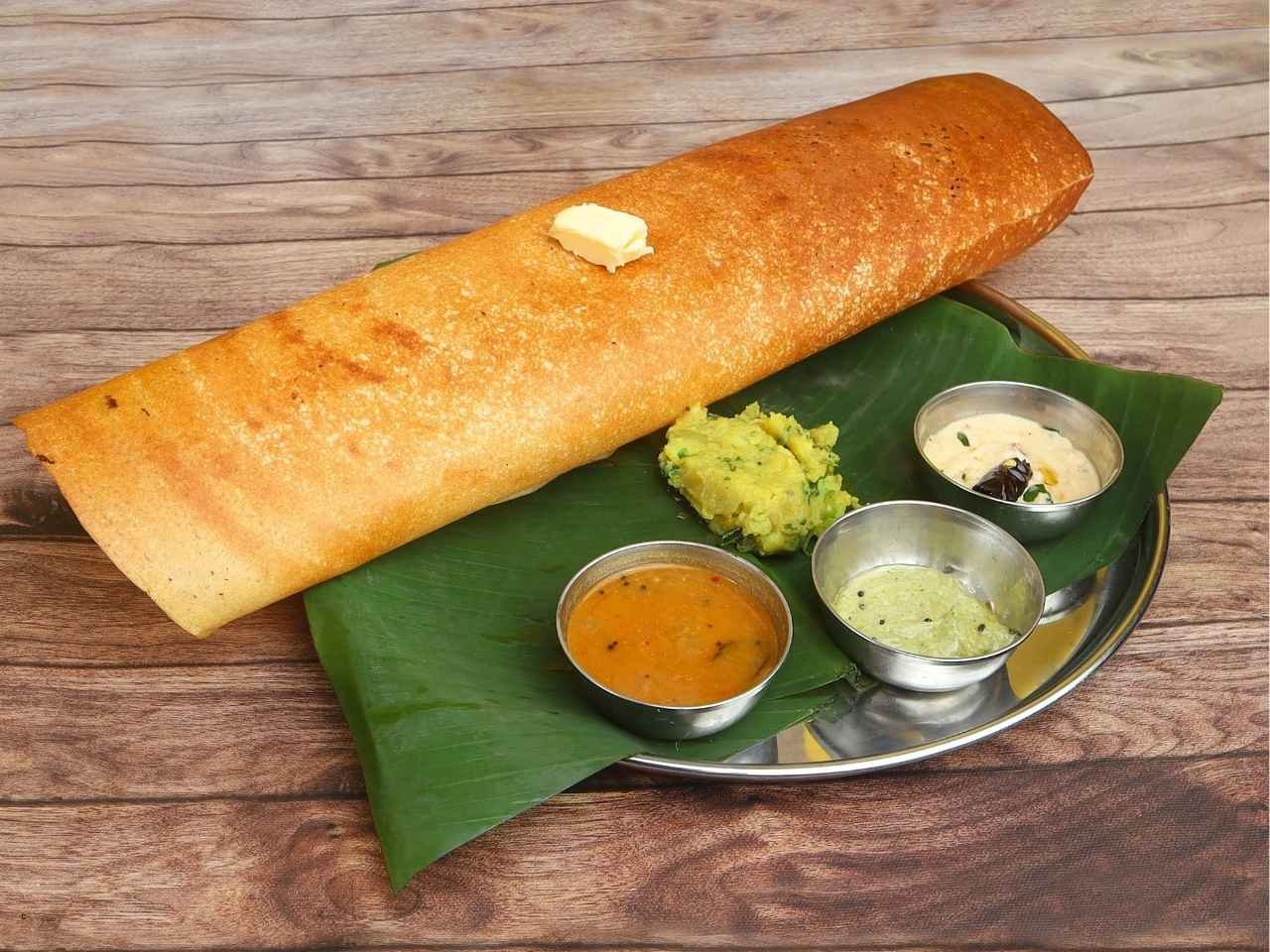
Andaman: A World Apart
At half past four in the morning, we were back at the airport for our early flight to the Andaman Islands. Sleep had been short, just four or five hours, but the mood was good. The terminal was already busy, and check-in moved quickly. I had never fully realised how far the Andamans are from mainland India. The flight lasted three hours and crossed over 1,300 kilometres of open sea. By the time we landed, we were closer to Southeast Asia than to Chennai.
The change in landscape was immediate. The trees, the light, the air—it all felt different. The Andamans have around twenty endemic birds, found nowhere else. That alone makes it a unique stop for any birder.
Most brochures mention the Andaman and Nicobar Islands as a pair, but in truth, the Nicobar group is closed to tourists. Most visits are centred around Port Blair and the smaller nearby islands. We stayed on the main island and explored its best birding spots over four days, keeping the pace easy and unhurried.
Each day brought good sightings. We recorded Andaman Bulbul, Cuckoo, Starling, Shama, Hawk-Owl, Serpent Eagle, and the elusive Andaman Crake. The habitats varied—coastal scrub, forest patches, and mangrove edges—all holding their own surprises. We spent long hours in the field, yet the island never felt tiring. On our final evening, we drove to a beach near Chidiya Tapu. The sun had dipped behind thick clouds, but the sea was calm. We sat on the sand, watching the tide move in slowly. It felt like the right way to close the chapter.
Back to the Mainland: Coimbatore and the Western Ghats
The next morning, we flew back to the mainland. Our flight touched down in Coimbatore, a city that once held the title of Manchester of the East because of its textile mills. At the airport, the local Endemic Explorer team was ready. They greeted us with quick introductions, loaded our bags, and we set off at once. The road ahead climbed into the Western Ghats.
This part of India holds a different kind of charm. The hills are home to species found nowhere else. It is the land of Nilgiri birds, lion-tailed macaques, and countless flowering plants. As the road rose, the air turned cooler, and the forests thickened. This was a landscape built for slow travel and sharp eyes.
Ooty: A Colonial Legacy Amidst Misty Hills
Ooty, once a military outpost under British rule, was used as a rest base for convalescing soldiers and officials. The cooler climate made it ideal. That legacy remains in its layout, its gardens, and a few of the old buildings. Today, it is a hill station known for its tea plantations, forest trails, and clear mountain air.
We arrived in Ooty around 7 in the evening. The air had turned crisp, and the temperature had dropped to three or four degrees. After the humidity of Assam and the warmth of the Andamans, it felt like a different season altogether. Winter here can be biting, but the body adjusts quickly after a day on the road. We checked into the hotel, had a quiet meal, and turned in early. Sleep came easily.

We spent two nights in Munnar. The hills were green, the air was fresh, and every corner seemed to hold something to pause for. One of the standout moments was a walk through the tea gardens. The light was soft, the path quiet, and then came the surprise. A group of wild elephants, grazing calmly in the distance. No one spoke. We just watched. It was one of those scenes that stays with you.
On the way out of Munnar, we stopped at a spice estate. Kerala’s plantations are known for their variety and scent, and this visit gave us a closer look at where so many familiar spices begin their journey. The smell of pepper, cardamom, and cinnamon hung in the air as we walked through the rows.
Thattekad: A Legendary Birding Haven
On the twenty-ninth day of our journey, we reached Thattekad Bird Sanctuary. The drive from Munnar took about two hours. The road dropped in altitude, and the forest began to change. Thattekad sits at the foot of the Western Ghats, a laid-back village surrounded by lowland forest. It is dense, warm, and full of life.
Dr Salim Ali once called Thattekad his favourite birding spot in India. David Attenborough had filmed an episode on woodpeckers here. That alone says a lot. The forest holds over 350 species, packed into a relatively small area. The trails are narrow, the hides are simple, and the birding is constant.
We had two full days here. Among the species we saw were Sri Lankan Frogmouth, Malabar Trogon, Malabar Laughingthrush, Malabar Parakeet, Malabar Hornbill, White-bellied Treepie, Nilgiri Flowerpecker, and Indian Scops Owl. We found the Ceylon Bay Owl. We had repeated views of Indian Pitta. At one hide, a Ruby-throated Bulbul stayed still long enough for everyone to get a clean shot. It felt like the birds had come out to greet us.
There were moments when no one said a word. Just shutters clicking. Light, movement, and colour. Thattekad had lived up to its name.
The End of an Unforgettable Journey
Two nights in Thattekad brought the trip to a close. Thirty-one days had passed, but it felt like we had just begun. The group had become more than travellers. It felt like a circle of friends. We had seen wild cats, rare birds, ancient forests, forgotten trails, and remote islands. And somewhere along the way, the boundaries between guide and guest had faded.
We were not ready to leave. No one ever is when a journey gets under the skin like this. But the bags were packed. The last birds had been logged. The road to Kochi Airport was quiet. Goodbyes were said with smiles and silence.
I had ticked 643 species. Over 380 were lifers. But more than the numbers, it was the feeling that stayed. As the plane took off and I looked down at the last stretch of green, I knew I would return.
Latest Post

Papua New Guinea Bird Photography Tour Report – 2024
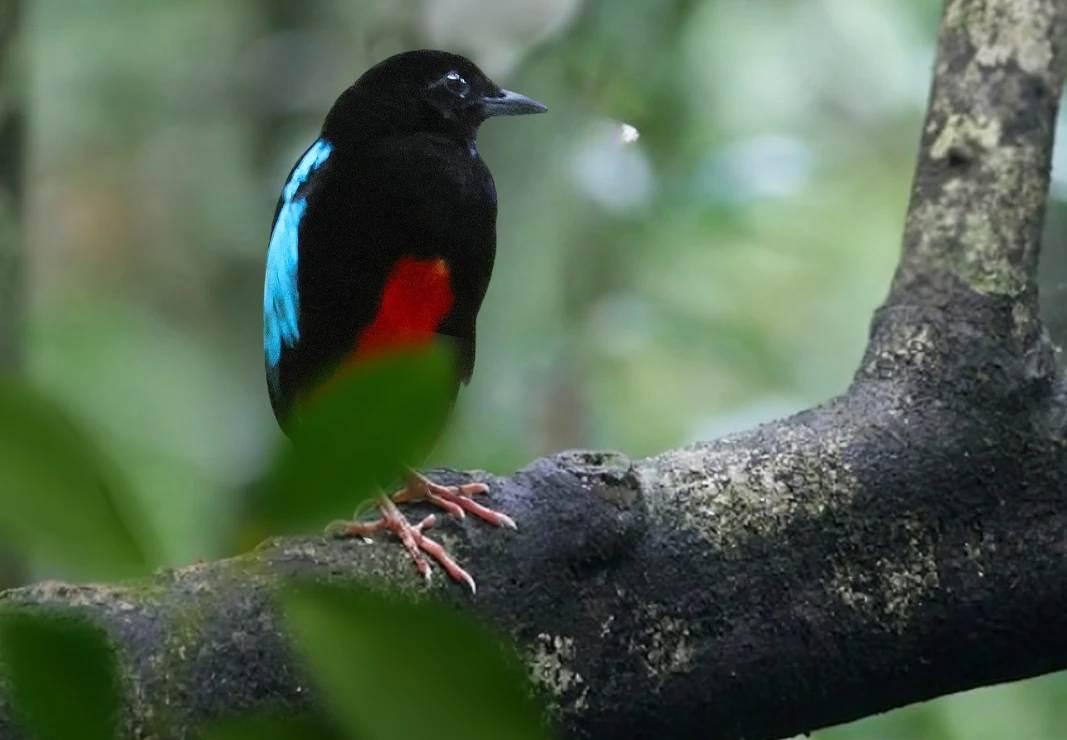
Chasing the Super Pitta: A Journey to Manus Island

